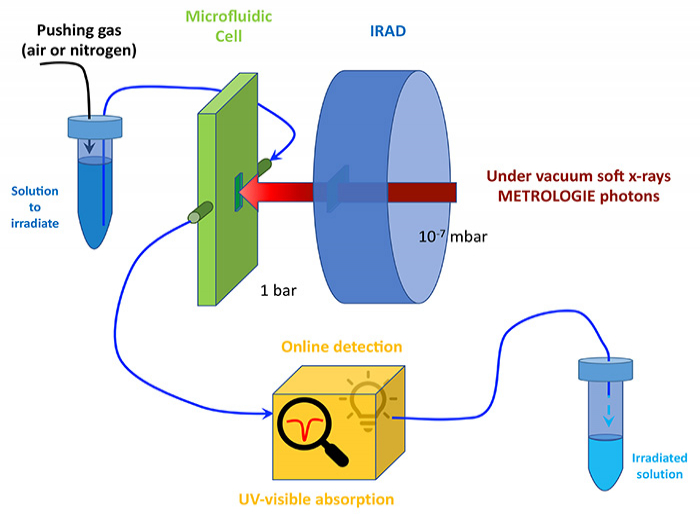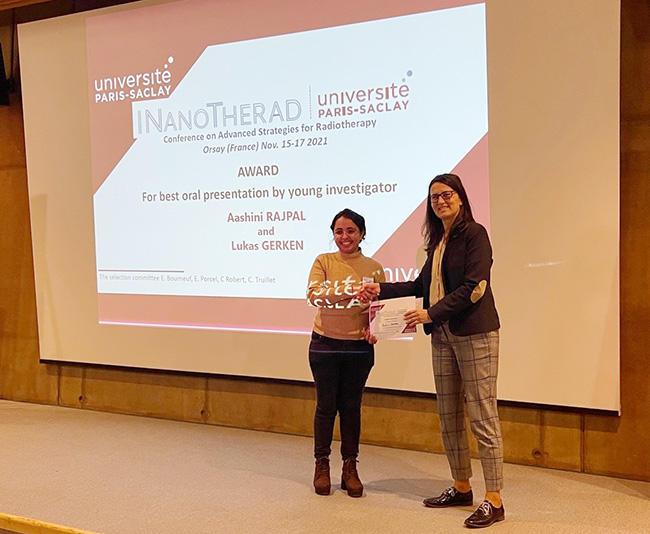From November 15 to 17, 2021, the international conference organized by INanoTheRad*: "Advanced Strategies for Radiotherapy: from the lab bench to medical application" brought together students and specialists in radiation physics and chemistry, but also in radiotherapy or oncology. Aashini Rajpal (CEA/Sorbonne University/SOLEIL) received one of the two prizes awarded for the best oral contribution of a young researcher, for her work carried out within the framework of her doctorate on the METROLOGIE beamline (SOLEIL), and relating to the detection of the anionic superoxide radical (HO2°) produced by ionization of a water solution with X-rays.
After a bachelor's degree in chemistry from the University of Delhi in India (St-Stephen College), Aashini Rajpal was selected in 2018 to receive an Erasmus Mundus scholarship and thus joined the SERP+ European master's degree, coordinated by the Université Paris-Saclay and taught in the framework of an international partnership (University of Genoa - Italy, University of Porto - Portugal, Adam Mickiewicz University of Poznan - Poland). With compulsory study mobility in at least two European universities, Erasmus Mundus-labeled masters programs enable students from all over the world to receive a double or multiple degree at the end of the program. These courses also promote intercultural experiences and the development of students' skills.
The subject of her thesis, directed by Jean- Philippe Renault (NIMBE/CEA) and co-supervised by Marie-Anne Hervé du Penhoat (IMPMC/Sorbonne University) and Christophe Nicolas (PLEIADES beamline, SOLEIL), is high-energy chemistry triggered by X-ray photons: Aashini Rajpal is trying to understand the role played by doubly ionized molecules, which can dissociate and generate other highly reactive chemical species. According to what is known in the case of heavy ions, the toxic superoxide radical (HO2°) could be generated in part from one of the reaction chains initiated by the dissociation of doubly ionized water molecules (H2O2+).
In order to quantify the production of the HO2° radical, measurements were carried out on the METROLOGIE beamline. They were carried out on a solution of water + WST-8, a "sensor" molecule: when it reacts with HO2°, it absorbs ultraviolet radiation.
As for the X-rays provided on METROLOGIE, they were not used to analyze the solution, but to irradiate it before analysis. One of the key elements of these irradiation studies is the very high spectral purity of the beamline X-rays: it allows (by a system of adjustable optical filter, known as “low pass”) to select only the wavelength of the desired irradiating radiation - of an energy of 1620 eV in this case.
The IRAD experimental set up installed on the beamline (see figure 1) includes a silicon nitride window allowing transmission of the soft X-rays supplied by SOLEIL at atmospheric pressure. Another key element is a microfluidic cell specially developed for solution irradiation by Corinne Chevallard (CEA/NIMBE), Lucie Huart (CEA/SOLEIL/IMPMC PhD student of the ANR HighEneCh project) and Stéphane Lefrançois (SOLEIL). Placed in front of the IRAD set-up, the solution to be irradiated (water + low concentration of WST-8) circulates in this cell at flow rates down to 1µL/min. At the exit of the cell, the reaction product between WST-8 and the HO2° radicals created during the water irradiation is directly detected by UV absorption spectroscopy.
.

Figure1: sketch of the experimental set-up on METROLOGIE
Thanks to a real-time baseline correction of the UV spectra, a sensitivity down to a concentration of 10-7 mol.L-1 was achieved. Moreover, the microfluidic cell allows a perfect control of the irradiation conditions, and the use of reduced quantities of solution. The yield of HO2° radical production as a function of the energy deposited in liquid water by X-rays can be directly used in physicochemical models simulating water irradiation (nuclear industry, radiotherapy, etc.).
Aashini Rajpal received one of the two prizes for the best oral contribution of young researchers by presenting these studies at the international conference organized by the interdisciplinary center for cancer therapies based on nanotechnologies and radiation (INanoTheRad*) of the Université Paris-Saclay.

Aashini Rajpal receives her prize, presented by Sandrine Lacombe, Professor at the Paris Saclay University and coordinator of iNanoTheRad, one of the 13 interdisciplinary objects of the Université Paris Saclay.
* The interdisciplinary INanoTheRad project brings together a large network of researchers, professors, and clinicians from UPSaclay who pool their expertise to advance practices and tools and propose new clinical solutions based on the use of innovative sources of irradiation, drugs, and radiation.
